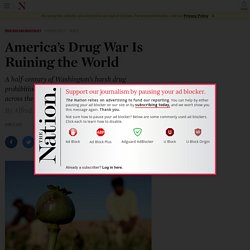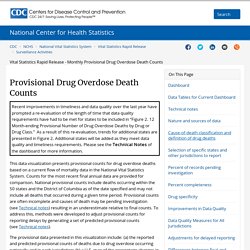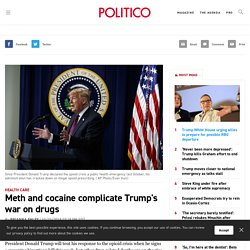

Drug war mass incarceration and race 01 18 0. Is the ‘War on Drugs’ Over? Arrest Statistics Say No. Drug arrests are classified into four categories: 1) heroin or cocaine and their derivatives, 2) marijuana 3) synthetic or manufactured drugs like fentanyl and 4) other dangerous non-narcotic drugs like barbiturates.

In 2018, there were 663,367 arrests involving marijuana, up from 659,700 in 2017, nearly 92 percent of them for possession. The F.B.I.’s crime data includes only the top charge for each arrest, so if a suspect is found with drugs while being arrested on a more serious charge, the drug possession would not be counted in the agency’s statistics. “I always caution people to read the U.C.R. data as an approximation because it’s imperfect,” said Tess Borden, a staff attorney with the American Civil Liberties Union who worked on a report published by the A.C.L.U. and Human Rights Watch in 2016: Every 25 Seconds: The Human Toll of Criminalizing Drug Use in the United States. This reporting system also contains information about the quantity of drugs involved in an arrest. The War on Drugs. Guiding Drug Law Reform & Advocacy. The U.S. and Mexico have waged war on drug cartels for decades. They've fallen short. An ambush that killed several American citizens living in Mexico has President Donald Trump calling for a war on drug cartels.

America’s Drug War Is Ruining the World. EDITOR’S NOTE: This article originally appeared at TomDispatch.com.

To stay on top of important articles like these, sign up to receive the latest updates from TomDispatch. We live in a time of change, when people are questioning old assumptions and seeking new directions. In the ongoing debate over health care, social justice, and border security, there is, however, one overlooked issue that should be at the top of everyone’s agenda, from democratic socialists to libertarian Republicans: America’s longest war. No, not the one in Afghanistan. I mean the drug war. For more than a century, the US has worked through the UN (and its predecessor, the League of Nations) to build a harsh global drug-prohibition regime—grounded in draconian laws, enforced by pervasive policing, and punished with mass incarceration. At its core, this netherworld was then and is today an invisible political realm inhabited by criminal actors and practitioners of Conein’s “clandestine arts.”
HuffPost is now a part of Verizon Media. The War on Drugs is Working. The War on Drugs is Burning Out. A 25-Year Quagmire: The War On Drugs and Its Impact on American Society. After the War on Drugs: Options for Control - Transform Drugs Policy Foundation. Trends & Statistics. Brief Description There are a variety of sources of information NIDA uses to monitor the prevalence and trends regarding drug abuse in the United States.

The resources below cover a variety of drug related issues, including information on drug usage, emergency room data, prevention and treatment programs, and other research findings. Costs of Substance Abuse Abuse of tobacco, alcohol, and illicit drugs is costly to our Nation, exacting more than $740 billion annually in costs related to crime, lost work productivity and health care. Report: The War on Marijuana in Black and White. End the War on Drugs. Products - Vital Statistics Rapid Release - Provisional Drug Overdose Data. Technical notes Nature and sources of data Provisional drug overdose death counts are based on death records received and processed by the National Center for Health Statistics (NCHS) as of a specified cutoff date.

The cutoff date is generally the first Sunday of each month. National provisional estimates include deaths occurring within the 50 states and the District of Columbia. Nixon's 'war on drugs' began 40 years ago, and the battle is still raging. Four decades ago, on 17 July 1971, President Richard Nixon declared what has come to be called the "war on drugs".

Nixon told Congress that drug addiction had "assumed the dimensions of a national emergency", and asked Capitol Hill for an initial $84m (£52m) for "emergency measures". Drug abuse, said the president, was "public enemy number one". But as reported the following morning in our sister newspaper, the Guardian, the president's initiative appears to have been primarily motivated not by considerations of the ghettoes or Woodstock festival, but by addiction among soldiers fighting in Vietnam: the first and immediate measure in the "war on drugs", implemented 40 years ago this weekend, was the institution of urine testing for all US troops in Indochina.
The Guardian's "sidebar" story to the news bulletin was not from Chicago or Los Angeles but the Mekong Delta, with soldiers laughing: "You can go anywhere, ask anyone, they'll get it for you. Meth and cocaine complicate Trump's war on drugs. President Donald Trump will tout his response to the opioid crisis when he signs a sweeping bipartisan bill this week, but other drug-related deaths are on the rise and little is being done to address the broader scourge of addiction.

Fatalities from misuse of methamphetamine, cocaine and benzodiazapines have surged while Washington’s latest efforts to fight drug addiction funnel new money and resources almost exclusively to localities ravaged by the opioid crisis or pay for treatments and overdose-reversal drugs that don't work for stimulants. Story Continued Below Trump on Wednesday will sign a 660-page bill Congress passed to combat the opioid crisis during a White House event aimed at showcasing his administration’s work on the issue. And while those efforts will direct around $4 billion to fight the epidemic, public health experts warn they miss an opportunity to address the broader issue of addiction, including the 80,000 Americans who die every year from alcoholism.